
Posca was an ancient Roman drink made by mixing water and wine vinegar. Bracing but less nutritious and palatable than wine, it was typically a drink for soldiers, the lower classes, and slaves.

Posca was an ancient Roman drink made by mixing water and wine vinegar. Bracing but less nutritious and palatable than wine, it was typically a drink for soldiers, the lower classes, and slaves.
The word posca is derived from either Latin potor 'to drink' or from Greek epoxos 'very sharp'. [1] Because the Greeks lacked a word for posca, sources written in Greek, such as the Gospels and Plutarch, use the word οξος, oxos 'vinegar' in its place (translated as acetum in the Vulgate Bible). The word eventually migrated into Greek from about the sixth century AD onward as the Byzantine army continued the Roman tradition, drinking what they termed phouska. This word (sometimes rendered phouska) may mean 'beer' in some contexts:
What it certainly meant originally, like Latin posca, was vinegar-and-water, the regular beverage of the classical Roman army on bad days. Thus Aëtius gives, and Paul of Aegina repeats, a recipe for a "palatable and laxative phouska" which includes cumin, fennel seed, pennyroyal, celery seed, anise, thyme, scammony, and salt to be added to the basic liquid, which is explicitly called oxykraton "vinegar diluted with water." [2]
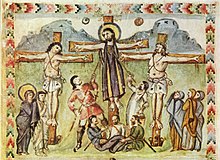
The widespread use of posca is attested by numerous mentions by ancient sources ranging from the Natural History of Pliny the Elder to the comedies of Plautus. When on campaign, generals and emperors could show their solidarity with common soldiers by drinking posca, as did Cato the Elder (as recorded by Plutarch) and the emperor Hadrian, who according to the Historia Augusta "actually led a soldier's life ... and, after the example of Scipio Aemilianus, Metellus and his own adoptive father Trajan cheerfully ate out of doors such camp-fare as bacon, cheese, and vinegar." A decree of AD 360 ordered that lower ranks of the army should drink posca and wine on alternate days. [3] The most famous mention of posca is in the Gospels, where Jesus is given a sponge soaked in oxos (conventionally translated as "vinegar") during his crucifixion; the Gospel of John mentions that it was given to him "on hyssop." [4] [5] Vinegar drinks with herbs were also used as medicine. Recipes can be found in medical scriptures like the P. Oxy. 1384. [6]
{{cite book}}: CS1 maint: location missing publisher (link)
Mead, also called honey wine, and hydromel, is an alcoholic beverage made by fermenting honey mixed with water, and sometimes with added ingredients such as fruits, spices, grains, or hops. The alcoholic content ranges from about 3.5% ABV to more than 20%. Possibly the most ancient alcoholic drink, the defining characteristic of mead is that the majority of the beverage's fermentable sugar is derived from honey. It may be still, carbonated, or naturally sparkling, and despite a common misconception that mead is exclusively sweet, it can also be dry or semi-sweet.

Myrrh is a gum-resin extracted from a few small, thorny tree species of the Commiphora genus, belonging to the Burseraceae family. Myrrh resin has been used throughout history in medicine, perfumery, and incenses. Myrrh mixed with posca or wine was widely used in many ancient cultures to produce pleasurable feelings and as an anti-inflammatory and analgesic.

The cuisine of ancient Rome changed greatly over the duration of the civilization's existence. Dietary habits were affected by the political changes from kingdom to republic to empire, and Roman trading with foreigners along with the empire's enormous expansion exposed Romans to many new foods, provincial culinary habits and cooking methods.

The Holy Sponge is one of the Instruments of the Passion of Jesus. It was dipped in vinegar, most likely posca, a regular beverage of Roman soldiers, and offered to Jesus to drink from during the Crucifixion, according to Matthew 27:48, Mark 15:36, and John 19:29.
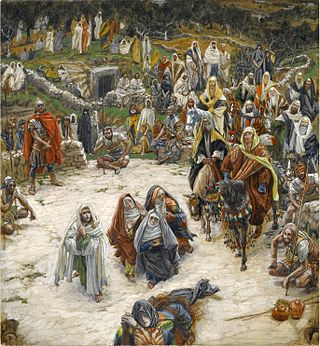
The sayings of Jesus on the cross are seven expressions biblically attributed to Jesus during his crucifixion. Traditionally, the brief sayings have been called "words".
Black soup was a regional cuisine of ancient Sparta, made with boiled pork meat and blood, using only salt and vinegar to flavour. The soup was well known during antiquity in the Greek world, but no original recipe of the dish survives today. The earliest recorded mention of the soup can be dated to the fifth century BC, in a comedy titled The Miners, written by Pherecrates. The ancient sources provide contradictory accounts on whether the soup was a luxurious meal served only at banquets or a dish that could be afforded by all Spartiates. Throughout history, black soup has been praised by and associated with figures such as Benjamin Rush and Adolf Hitler, although Hitler was (debatably) vegetarian.

Switchel, switzel, swizzle, switchy, ginger-water, or haymaker's punch, is a drink made from water mixed with vinegar and often seasoned with ginger. It is typically sweetened with molasses, although honey, sugar, brown sugar, or maple syrup may also be used. In the U.S. state of Vermont, oatmeal and lemon juice were sometimes added to the beverage.
Kyphi, cyphi, or Egyptian cyphi is a compound incense that was used in ancient Egypt for religious and medical purposes.
Ancient Greek cuisine was characterized by its frugality for most, reflecting agricultural hardship, but a great diversity of ingredients was known, and wealthy Greeks were known to celebrate with elaborate meals and feasts.
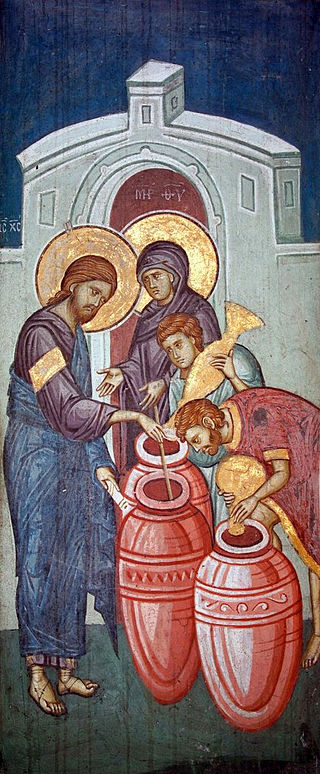
Christian views on alcohol are varied. Throughout the first 1,800 years of Church history, Christians generally consumed alcoholic beverages as a common part of everyday life and used "the fruit of the vine" in their central rite—the Eucharist or Lord's Supper. They held that both the Bible and Christian tradition taught that alcohol is a gift from God that makes life more joyous, but that over-indulgence leading to drunkenness is sinful. However, the alcoholic content of ancient alcoholic beverages was significantly lower than that of modern alcoholic beverages. The low alcoholic content was due to the limitations of fermentation and the nonexistence of distillation methods in the ancient world. Rabbinic teachers wrote acceptance criteria on consumability of ancient alcoholic beverages after significant dilution with water, and prohibited undiluted wine.

The oldest evidence of ancient wine production has been found in Georgia from c. 6000 BC , Iran from c. 5000 BC, Greece from c. 4500 BC, Armenia from c. 4100 BC, and Sicily from c. 4000 BC. The earliest evidence of fermented alcoholic beverage of rice, honey and fruit, sometimes compared to wine, is claimed in China.

A sponge is a cleaning aid made of soft, porous material. Typically used for cleaning impervious surfaces, sponges are especially good at absorbing water and water-based solutions.

Alcoholic beverages appear in the Hebrew Bible, after Noah planted a vineyard and became inebriated. In the New Testament, Jesus miraculously made copious amounts of wine at the wedding at Cana. Wine is the most common alcoholic beverage mentioned in biblical literature, where it is a source of symbolism, and was an important part of daily life in biblical times. Additionally, the inhabitants of ancient Israel drank beer and wines made from fruits other than grapes, and references to these appear in scripture. However, the alcohol content of ancient alcoholic beverages was significantly lower than modern alcoholic beverages. The low alcohol content was due to the limitations of fermentation and the nonexistence of distillation methods in the ancient world. Rabbinic teachers wrote acceptance criteria on consumability of ancient alcoholic beverages after significant dilution with water, and prohibited undiluted wine.
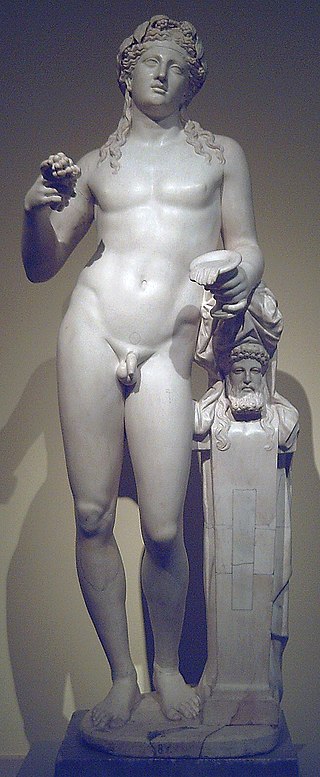
Ancient Rome played a pivotal role in the history of wine. The earliest influences on the viticulture of the Italian Peninsula can be traced to ancient Greeks and the Etruscans. The rise of the Roman Empire saw both technological advances in and burgeoning awareness of winemaking, which spread to all parts of the empire. Rome's influence has had a profound effect on the histories of today's major winemaking regions in France, Germany, Italy, Portugal and Spain.

Stephaton, or Steven, is the name given in medieval Christian traditions to the Roman soldier or bystander, unnamed in the Bible, who offered Jesus a sponge soaked in vinegar wine at the Crucifixion. In later depictions of the Crucifixion, Stephaton is frequently portrayed with Longinus, the soldier who pierced Jesus' side with a spear.

In terms of mixed drinks, shrub is the name of two different, but related, acidulated beverages. One type of shrub is a fruit liqueur that was popular in 17th and 18th century England, typically made with rum or brandy and mixed with sugar and the juice or rinds of citrus fruit.
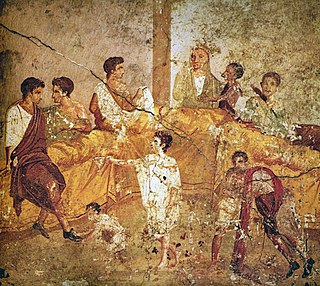
Food in ancient Rome reflects both the variety of food-stuffs available through the expanded trade networks of the Roman Empire and the traditions of conviviality from ancient Rome's earliest times, inherited in part from the Greeks and Etruscans. In contrast to the Greek symposium, which was primarily a drinking party, the equivalent social institution of the Roman convivium was focused on food. Banqueting played a major role in Rome's communal religion. Maintaining the food supply to the city of Rome had become a major political issue in the late Republic, and continued to be one of the main ways the emperor expressed his relationship to the Roman people and established his role as a benefactor. Roman food vendors and farmers' markets sold meats, fish, cheeses, produce, olive oil and spices; and pubs, bars, inns and food stalls sold prepared food.

Grape syrup is a condiment made with concentrated grape juice. It is thick and sweet because of its high ratio of sugar to water. Grape syrup is made by boiling grapes, removing their skins, and squeezing them through a sieve to extract the juice. Like other fruit syrups, a common use of grape syrup is as a topping to sweet cakes, such as pancakes or waffles.

Salep, also spelled sahlep or sahlab, is a flour made from the tubers of the orchid genus Orchis. These tubers contain a nutritious, starchy polysaccharide called glucomannan. Salep flour is consumed in beverages and desserts, especially in the cuisines of the former Ottoman Empire, notably in the Levant where it is a traditional winter beverage. An increase in consumption is causing local extinctions of orchids in parts of Turkey and Iran.
Cleopatra the Physician was a Greek medical writer and author of a manual entitled Cosmetics. Six fragments of her Cosmetics survive in quotation from later medical writers.